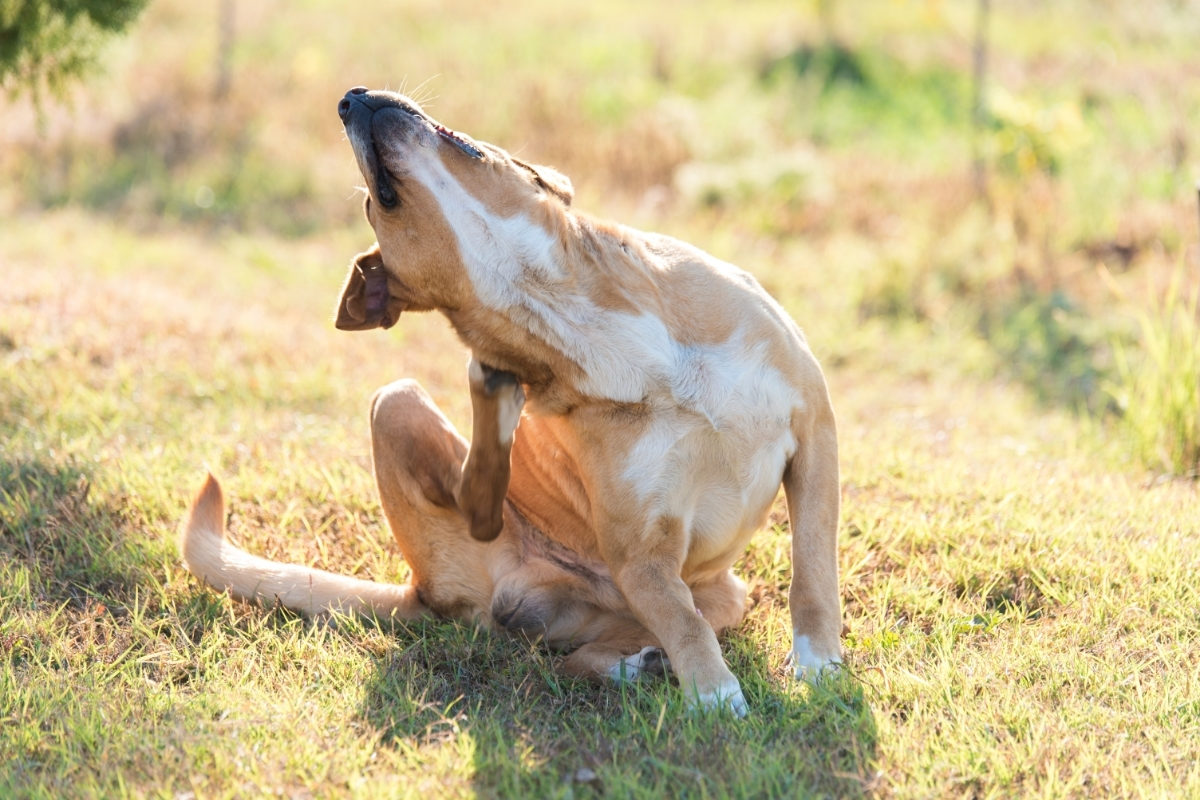If you’ve ever noticed your Labrador relentlessly scratching, you’re not alone. Many dog owners ask, “Why does my Labrador itch so much?”
This common canine conundrum can stem from various causes, ranging from environmental allergens to dietary issues and underlying health conditions.
Labradors may experience itchiness for several reasons, such as allergies (commonly to certain foods, environmental allergens, or flea bites), skin infections, or even breed-specific conditions like atopic dermatitis. Their dense coats can also trap dirt and moisture, irritating skin.
In this article, we’ll navigate through the various factors that could be causing your Labrador’s incessant itching and discover practical solutions to alleviate their distress.
Recognizing what’s at the heart of this itching is crucial for your dog’s comfort and contentment.
Join us as we dive into the world of canine skin health, unraveling the complexities behind your dog’s itchiness and seeking the most effective strategies.
Let’s get started!

Why Does My Labrador Itch So Much?
We all know an itchy Labrador can turn cuddle time into a scratch fest. But what’s causing all this itchiness?
From pesky fleas to sneaky allergies, we’ll dive into the common culprits behind your Lab’s itch and share some tips on how to give them the relief they need. So, let’s get started and help your furry best friend feel more comfortable!
Understanding Atopy in Labradors: Signs & Symptoms
Your Labrador might be itching due to one or more reasons. The most likely explanation is that he has atopic dermatitis if there are no signs of pesky fleas.
This is a common allergic skin disease known to affect around 10% of all dog breeds. It causes mild to severe itching, leading to more skin damage, infection, and irritation.
Unfortunately, Labrador Retrievers are prone to itching due to atopic dermatitis. Dogs with this condition should not be bred as there is a higher chance that the puppies will inherit it.
But instead of applying a remedy for your Labrador’s itching, you should first ensure he has atopy!
To do this, you can check that most of the symptoms in this section apply to your dog. Your veterinarian will also follow a set of recommended practical guidelines to help diagnose canine AD.
Your Labrador Bites His Paws
If you see your Labrador biting his front paws, chances are he has atopy. Fleas go for more fur-covered skin, making it more likely that your dog’s feet are itchy because of atopy.
There’s still a tiny possibility that oversensitivity to bacteria is the cause. That’s why you must use this symptom as an item on the checklist, not as a diagnosis confirmation.

Your Lab is Rubbing His Face
If your Labrador tries to satisfy an itch around his eyes and ears, he could have a skin disease. But with other symptoms on this list present, it is more likely that this allergy is atopic dermatitis.
A contact allergy might also be the culprit since dogs are often petted around this region.
Your Lab Bites His Inner Thigh or Rubs His Groin
It is easy to mistake your Labrador’s groin-rubbing tendency for his reaching sexual maturity, but mating behavior varies significantly from scratching an itchy groin.
You can tell this behavior apart if you have raised a dog or seen one trying to mate!
Your Lab’s Saliva Has a Staining Effect
This will be more prominent over lighter hair as the staining will be more obvious. If the fur around your Labrador’s mouth seems to be turning orange, the likelihood of atopy is higher.
Mites and even contact allergens aren’t as likely to cause this. However, this doesn’t always happen, so your dog might still have atopy without this symptom.
Your Labrador’s Itching is Seasonal
Atopic dermatitis’s actual identifier is that your dog only itches during a specific season (usually between the spring and fall). The allergens that trigger an atopic dog to scratch are typically inhaled and environment-based.
The problem with relying on this symptom as confirmation is that you must wait for the season to pass. And in the meantime, your Labrador’s condition could worsen.
So please read the rest of this article to learn what else you should do.

What are Labradors Allergic To?
Before we get into my step-by-step method of reducing itching and scratching in your Labrador, we have to consider other reasons he might be itching.
Only once you know all possibilities can you actively eliminate them till your beloved doggo is itch-free.
Labradors can be allergic to environmental inhalants like pollen, dust, mold, skin contact allergens, and certain foods. They may also have fleas or bacterial hypersensitivity that are causing the itch.
You can determine the cause of a dog’s irritation by identifying what recently changed and reversing it to observe the effects.
Let’s suppose you recently changed your dog’s food. If the itching starts within a week, you can eliminate this food item and bring back the old brand to see if the itching stops or slows down.
If it doesn’t, the food change may have been more of a coincidence than a cause.
Contact With Chemicals or Plants
Your Labrador might have contact allergies that are either seasonal or material-specific. Seasonal contact allergies make your pet itchy all over, while material-specific allergies cause patches of the skin to become itchy, inflamed, or bumpy.
You may spot dry, thickened skin if you run your hand through his fur. If your dog has been scratching himself too vigorously, there might be prominent discharge from the affected area or scarring.
A material-specific allergic reaction can happen from the presence of a normally harmless substance, chemical, or plant.
Make sure you audit all the new items that your Labrador is introduced to – whether it is a new detergent with which you cleaned your dog’s pillow or a new stuffed toy.
Inhaling Pollen or Other Airborne Particles
The section above on canine atopic dermatitis best explains what happens when your dog’s body reacts to such allergies.
Mostly, things that cause breathing-related issues in humans can cause itching in Labradors. Therefore, pollen, smoke, and similar stimuli that lead to sneezing or a blocked nose in humans can cause itching in dogs.
This itch isn’t dangerous in itself. However, dogs don’t understand that they must not scratch themselves too vigorously! By opening up wounds in their skin, dogs become more vulnerable to secondary itching.
Meat and Animal-Based Food Items
If you have recently changed your dog’s food, he is possibly itching because he is allergic to the new dog food.
It might seem easy to buy a pack of your old dog food and see if the change makes a difference, but I know not all dog moms and dads can do this.
I could switch my dog’s food in a week. But I might need to consider my budget before making that call if I have three dogs and buy all their food in bulk!
Also, one thing to consider is that a food allergy is not as common as dog food manufacturers would have you believe! Recent data from Banfield Pet Hospital evidenced that food allergies affect just 0.2 % of dogs!
Having said that, causes of allergies in dogs often overlap, making a diagnosis difficult, even for your veterinarian.

Foods That Often Trigger Canine Allergies
Proteins such as beef and chicken would be likely culprits if your Labrador were to suffer from a food allergy. You can also check your dog food packaging to see if one or more of the following ingredients are included:
- Corn
- Wheat
- Eggs
- Soy
- Chicken
- Beef
- Dairy
If you notice any of these in your dog food’s ingredients, try holding that food while introducing a variety free of the said ingredient.
In case the scratching persists, you can return to old food, as that was not the allergen causing the itch in the first place.
Please note that while Labradors can develop allergies related to the above, that doesn’t mean the items listed above are inherently harmful to all Labradors.
You don’t need to keep your dog from having meat just because some dogs can become allergic to beef!
Remember, the number of food allergies in dogs is extremely low!
Learn More About The Different Causes Of Itching In Your Dog…
How To Get Your Labrador to Stop Itching
Now that you know the most common causes of itching in Labradors, you can find a solution and try some ideas before taking your dog to the vet.
You should start with the lowest-effort solution and slowly work your way up to the highest-investment solution. The rationale is simple: you should do as much as necessary to relieve your dog’s discomfort.
Determine Whether the Itch is Contact or Environment-Based
The first step in getting your Labrador to stop itching is to find out what’s irritating. The earlier part of this article will help you determine whether the itch is contact-based or due to an inhaled allergen.
Making this determination early will allow you to skip some of the steps listed below so you can go directly to ones relevant to your Lab’s itch.
Replace Your Labrador’s Food
The lowest-effort step in this process is to swap your Labrador’s food. If you haven’t changed your dog’s diet in a while, he might be itchy because of his food, or the manufacturer might have altered the ingredients.
Simply holding your current stash while getting a different brand is a decent step in the right direction. Of course, this step is skippable if you’ve already ruled out food allergies.
Remove Recent Items from Your Dog’s Environment
Whether your Labrador has a new pillow or the wallpaper near his bed has been recently changed, you must subtract the things introduced just before he started itching from his environment.
An easy way to do this is to note the rough date when your dog started scratching himself.
Then note the date a week or two before that and start auditing your living space to observe which new things have been added.

Change Your Dog’s Environment
This solution applies only if your Labrador has an allergy related to inhaling pollen or other airborne particles. Once you’re sure of this, you can leave your dog with a family member for a day or two – if they live in a less pollen-affected area.
If this controls the itching, you may deduce a seasonal problem. Of course, swapping apartments for your dog’s spring allergy would not be feasible! Fortunately, you don’t have to change the environment.
How to Minimize Your Lab’s Inhalant Allergies
You must use anti-allergy products and protective measures to get your Labrador through the difficult period. Here are some steps you can take to minimize his environmental allergies:
- Keep Your Doors and Windows Shut at All Times – This will prevent excessive dust and pollen from entering your living space.
- Use an Air Purifier – By collecting tiny particles like dust, pollen, and mold spores, air purifiers help create a cleaner, healthier atmosphere.
- Groom Regularly to Get Rid of Pollen and Dust – Labradors have two coats and require a lot of grooming throughout the year. To prevent allergies, I use the FURminator de-shedding tool from Amazon, which works well because it penetrates the undercoat and safely removes loose hair and any nasty allergens! I’ve tried cheaper grooming tools and brushes but haven’t found any as good as the FURminator range.
- Move All Indoor Plants Outside Your Dog’s Room – Whether you keep your dog in a studio apartment or have a three-bedroom house dedicated to him, you can’t have plants in the area he mainly occupies! This can be tricky because some indoor plants might die when moved outside, but you can find an indoor solution away from your dog’s favorite room.
- Shower and Change When You Return Home – The urge to hug your best friend when you return from work or even a grocery trip is always strong. But for your dog’s sake, you must first shower and change so he doesn’t get exposed to pollen and other particles.
- Vacuum Your Carpets and Wipe the Dust off Surfaces Regularly – Use a wet rag to wipe the dust off areas close to your dog’s nose. This includes bedposts, tables, and chairs. You should also vacuum your carpet or rug to remove the trapped particles from your dog’s environment.
- Use a Dehumidifier – Dehumidifiers remove moisture from your home. By drying the air, allergy triggers are minimized, and symptoms are alleviated. Dust mites, for example, need a high humidity level of 65% to live. You can also prevent mold with the use of dehumidifiers.
Note: Clicking the above link(s) will take you to Amazon or an online store where we have an affiliate relationship. If you make a purchase, we may earn a commission at no additional cost to you.
Best Anti-Allergy Products for Your Lab
Now that you have learned how to identify your Labrador’s itching source and how to minimize it through protective measures, let’s explore the best anti-allergy products.
You can use my recommended products alongside the protective measures depending on compatibility.
You may not need to implement drastic changes if they help eliminate the problem. Remember to check with your vet first before using any of them.
1. Allergy Itch Relief Dog Shampoo
Whether your Labrador loves baths or is reluctant to get one, an itch-relief shampoo is his best friend.
As you’ve learned, dogs can develop itching due to pollen, seasonal irritants, and flea bites. Vet’s Best Allergy Itch Dog Relief Shampoo helps relieve itchy skin caused by all those factors.
- RELIEF FOR ITCHY SKIN - Vet’s Best Allergy Itch Relief Dog Shampoo is a soothing, natural remedy for dogs with itchy skin due to allergies or sensitivity.
- EFFECTIVE AND PLEASING - Washes away allergens, relieves itchy skin, and leaves your dog smelling spa-day fresh.
- NATURAL REMEDY - We use a veterinarian formulated blend of essential oils and key natural ingredients (such as oatmeal, d’limonene, and tea tree oil) to calm and moisturize itchy, red skin.
- USE AS NEEDED - Vet’s Best Allergy Itch Relief Dog Shampoo may be used as often as necessary to remove allergens without drying out your dog’s skin.
- WORKS WITH OTHER TREATMENTS - Will not affect topical flea and tick control produc
Prices pulled from the Amazon Product Advertising API on:
Product prices and availability are accurate as of the date/time indicated and are subject to change. Any price and availability information displayed on [relevant Amazon Site(s), as applicable] at the time of purchase will apply to the purchase of this product.
This shampoo won’t make your Labrador immune to scratching, but it will help him soothe his itch and relieve his discomfort. So expect to give your Labrador frequent baths with this shampoo.
When you walk your dog, airborne allergens often stick to his coat. This product helps clean those out while moisturizing your Labrador’s skin and coat. It’s backed by the trusted Vet’s Best brand and is formalized by vets.
I particularly like this one, as it has thousands of top-star reviews and features anti-allergy ingredients, including Lavender, Vitamin E, Oatmeal, Aloe, Tea Tree Oil, and Neem Oil.
Some shampoos will dry your dog’s skin, but this product is friendly to sensitive skin.
2. Itch Relief Spray
If you realize that your dog’s itching is due to direct contact with an irritant, or you need to help soothe hot spots or seasonal skin irritation, then you need to use a spray-specific relief solution.
Vet’s Best Hotspot Itch Relief Spray is a trusted brand that works with qualified vets to formulate its products safely and effectively.
- IMMEDIATE RELIEF - Vet’s Best Hot Spot Spray for Dogs provides immediate relief for itchy, dry, and irritated dog skin on contact, helping to soothe hot spots and seasonal skin irritation.
- PLANT-BASED INGREDIENTS - A unique blend of natural key ingredients, including tea tree oil, aloe vera, and chamomile, provides fast and effective relief.
- NO-STING FORMULA - Our alcohol-free, no-sting formula provides soothing relief for red, raw, or inflamed skin. Does not contain steroids such as hydrocortisone.
- IT WORKS - Guaranteed effective and will not affect topical flea and tick control products.
- VET’S FORMULA - Veterinarian formulated and recommended, and made in the USA with quality US and imported ingredien
Prices pulled from the Amazon Product Advertising API on:
Product prices and availability are accurate as of the date/time indicated and are subject to change. Any price and availability information displayed on [relevant Amazon Site(s), as applicable] at the time of purchase will apply to the purchase of this product.
This spray is excellent for itching caused in a specific spot. Due to fleas, dryness, or contact, simply spraying it on the irritated area will immediately relieve your dog. The spray supports your Labrador’s healing process, but ultimately, the skin self-heals.
Moisturizing and getting rid of dryness (and other irritants) in the process prevents your Lab from scratching or biting and causing further damage to the itchy area.
The product is tried and tested with over 12,000+ top reviews and ratings. But, a word of caution: while the spray is safe for your dog’s skin, it is not meant to be consumed orally!
You may need shampoo if your Labrador licks himself to relieve the itch. But if the itchy spot is out of your dog’s reach, then this product is excellent. I recommend it for your dog’s back, closer to his neck, his head, and around the ears.
3. Allergy Supplements – Chews
Speaking of products that are safe for oral consumption, I recommend allergy immunity supplements. Many supplements are available on the market, but their effectiveness varies drastically.
However, I am pleased to recommend Zesty Paws Aller-Immune Bites as they have enough proof of their concept in their 75,000+ reviews!
- America’s #1 Selling Dog Supplement Brand on Amazon*
- Mini Immune Support - These functional mini pet supplements support canine immunity and digestive function, plus it’s formulated for sensitive skin, and may help maintain normal histamine levels for your doggy.
- Features EpiCor Pets - This whole food yeast fermentate helps support the immune system for your pup.
- Skin & Immunity Support - Includes Colostrum and Astragalus Root which may support normal histamine levels and immune response, while Alaska sourced Omega-3 Salmon Oil (EPA & DHA fatty acids) supports skin health.
- Supports Gut Health - These tasty chewables contain probiotics (with Lactobacillus acidophilus) for normal gut flora and immune system activity support.
- Treat Your Pup to Pawsome Ingredients - With premium ingredients that support digestion, immune function, and seasonal allergies, these chews are great for your adult or senior dogg
Prices pulled from the Amazon Product Advertising API on:
Product prices and availability are accurate as of the date/time indicated and are subject to change. Any price and availability information displayed on [relevant Amazon Site(s), as applicable] at the time of purchase will apply to the purchase of this product.
Each container has 90 chews that boost your dog’s immune system, promote skin health, and improve gut health.
They contain all-natural proven ingredients and even have salmon fish oil that provides Omega-3 fatty acids to support your dog’s itchy skin and hot spots.
Final Thoughts
Your Labrador may be itching and scratching because of canine atopic dermatitis or an allergic reaction to airborne, food, or contact-based allergens.
Either way, the best solution is to eliminate the cause by reducing his exposure to the allergen.
You can also try washing him with anti-allergy shampoo and give him allergy immunity supplements.
If nothing seems to be working and his itching is not improving, it’s time to visit your vet. Don’t worry, though, as some advanced treatment options for atopic dermatitis, such as allergy shots, can help around 75% of dogs.








